Schools & GroupsEducational StandardsGrades K-2
NGSS & Common Core Projects:
Grades K-2
Build creative confidence and technical literacy, while meeting state and national academic standards. Every activity kit includes illustrated instructions, age-appropriate readings, and kid-led discoveries. Projects can also be extended to enrich any NGSS or Common Core lesson plan.

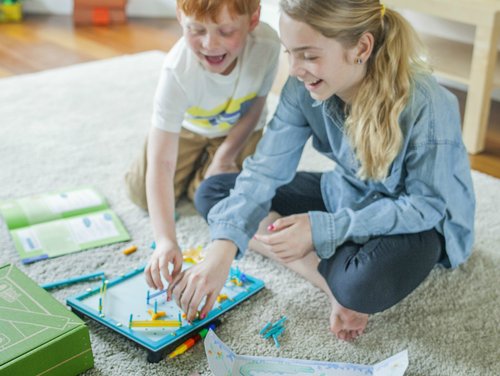
Pinball Machine
See standards ➜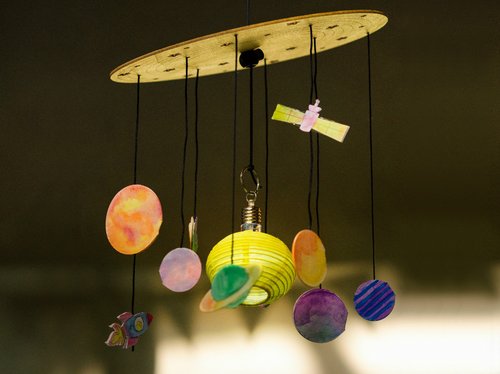
Solar System
See standards ➜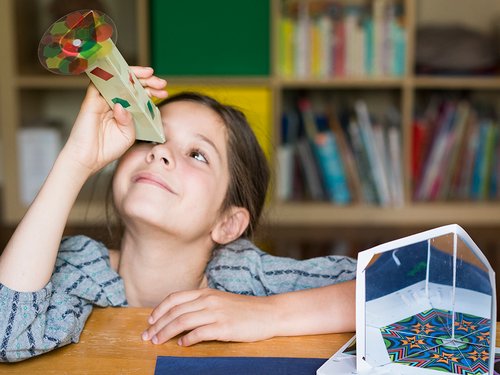
Kaleidoscope Play
See standards ➜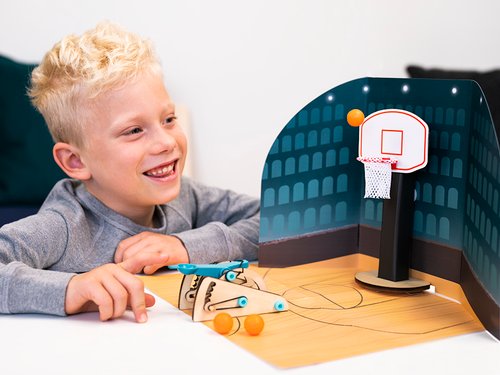
Basketball Catapult
See standards ➜
Fun with Flight
See standards ➜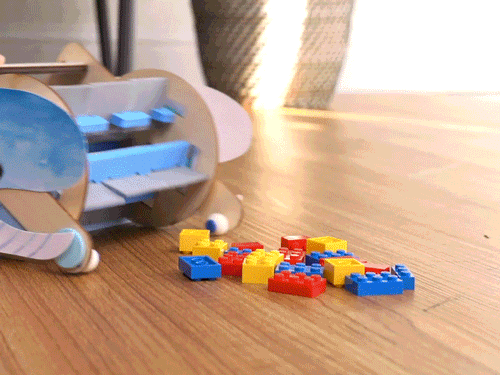
Mechanical Sweeper
See standards ➜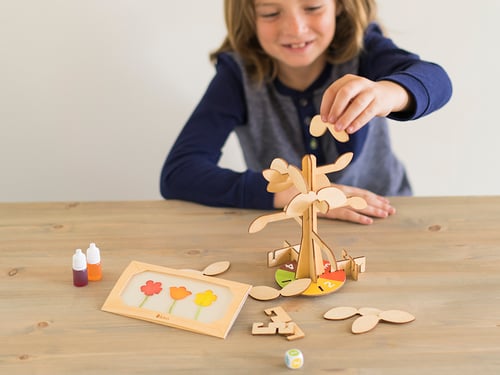
Capillary Action
See standards ➜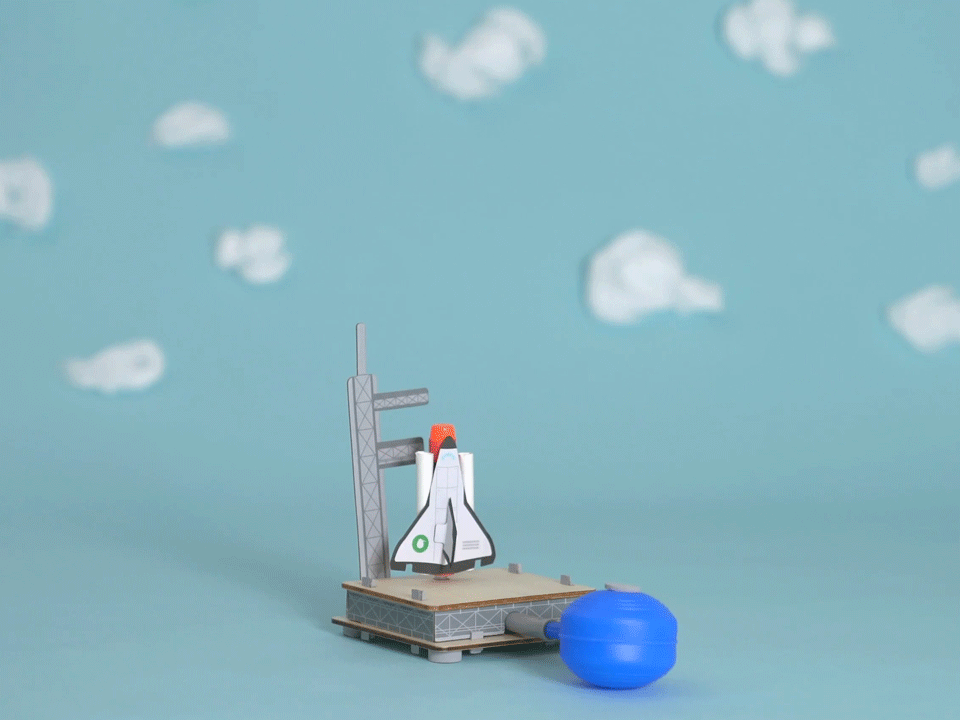
Astronaut Starter Kit
See standards ➜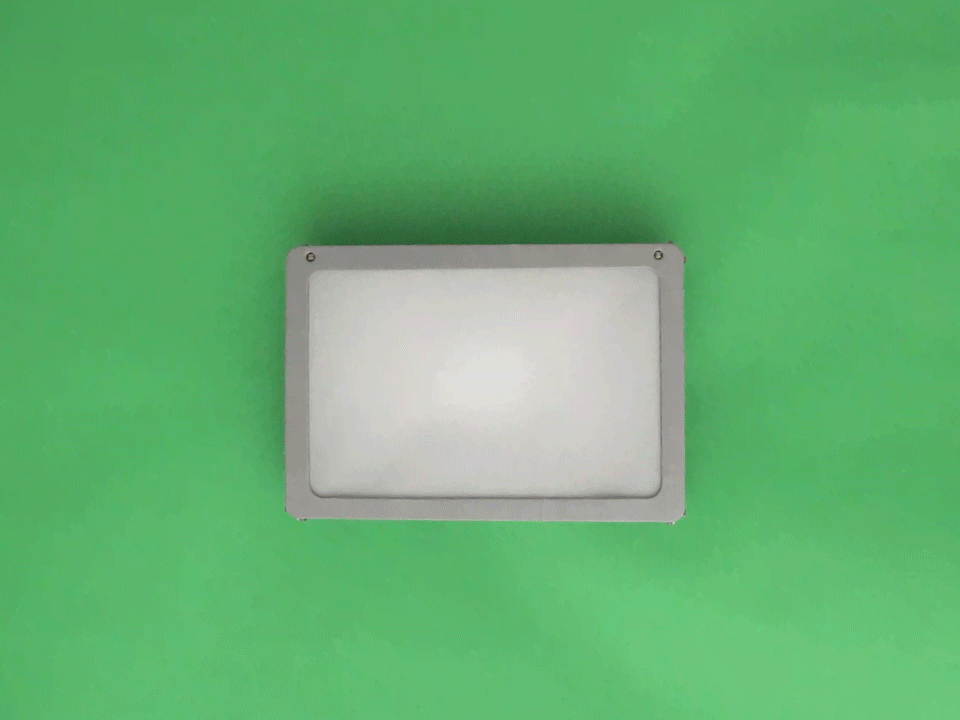
Veterinarian Starter Kit
See standards ➜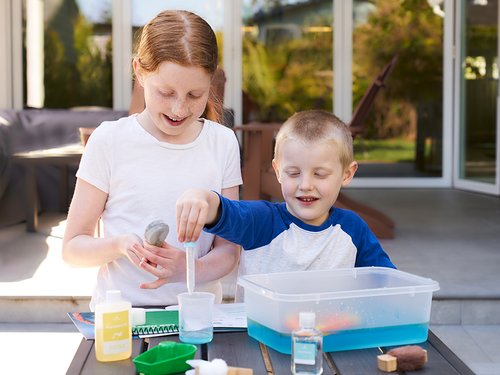
Environmental Science: Oil Cleanup
See standards ➜
Environmental Science: Oil Cleanup
See standards ➜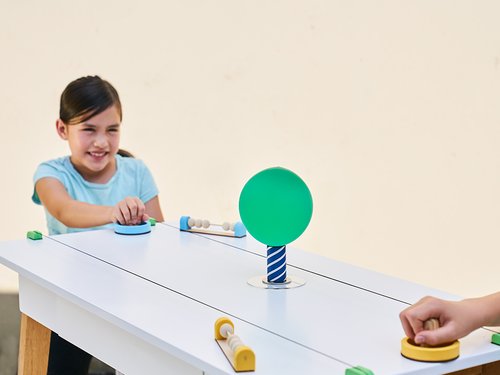
Air Hockey
See standards ➜
Air Hockey
See standards ➜Pinball Machine
Learn More ➜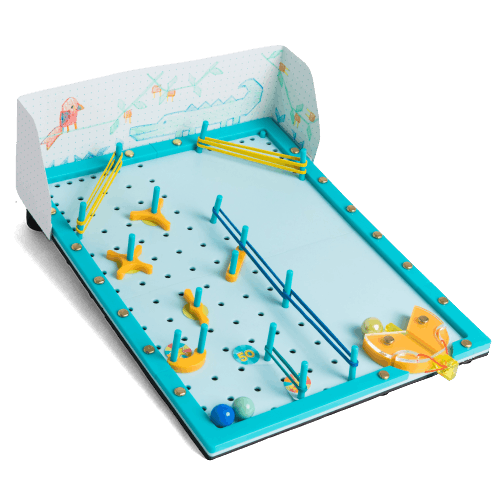
NGSS
3-PS2-1 Plan and conduct an investigation to provide evidence of the effects of balanced and unbalanced forces on the motion of an object.
MS-PS2-1 Apply Newton’s Third Law to design a solution to a problem involving the motion of two colliding objects.
Activity Applications
Construct a pinball machine to demonstrate how an object’s motion changes when it collides with another object.
Conduct experiments to investigate how an unbalanced force on one side of a ball causes it to start moving, but forces that are perfectly balanced will cause the ball to stay still.
Common Core
RI.1.3 Describe the connection between two individuals, events, ideas, or pieces of information in a text.
RI.2.3 Describe the connection between a series of historical events, scientific ideas or concepts, or steps in technical procedures in a text.
RI.3.3 Describe the relationship between a series of historical events, scientific ideas or concepts, or steps in technical procedures in a text, using language that pertains to time, sequence, and cause/effect.
Activity Applications
Make connections between push and pull forces and gameplay on the pinball machine.
RI.1.4 Ask and answer questions to help determine or clarify the meaning of words and phrases in a text.
RI.2.4 Determine the meaning of words and phrases in a text relevant to a grade 2 topic or subject area.
RI.3.4 Determine the meaning of general academic and domain-specific words and phrases in a text relevant to a grade 3 topic or subject area.
Activity Applications
Ask questions and use context clues to learn new vocabulary related to motion and engineering design.
RI.1.5 Know and use various text features (e.g., headings, tables of contents, glossaries, electronic menus, icons) to locate key facts or information in a text.
RI.2.5 Know and use various text features (e.g., captions, bold print, subheadings, glossaries, indexes, electronic menus, icons) to locate key facts or information in a text efficiently.
RI.3.5 Use text features and search tools (e.g., key words, sidebars, hyperlinks) to locate information relevant to a given topic efficiently.
Activity Applications
Use bold print, tip text, headings, and icons to locate key information in the explore! Magazine and Inspiration Sheet.
RI.1.6 Distinguish between information provided by pictures or other illustrations and information provided by the words in a text.
Activity Applications
Examine information given in both illustrations and text and identify how they support each other.
RI.1.7 Use the illustrations and details in a text to describe its key ideas.
RI.2.7 Explain how specific images (e.g., a diagram showing how a machine works) contribute to and clarify a text.
RI.3.7 Use information gained from illustrations (e.g., maps, photographs) and the words in a text to demonstrate understanding of the text (e.g., where, when, why, and how key events occur).
Activity Applications
Refer to illustrations and diagrams to describe scientific concepts.
Solar System
Learn More ➜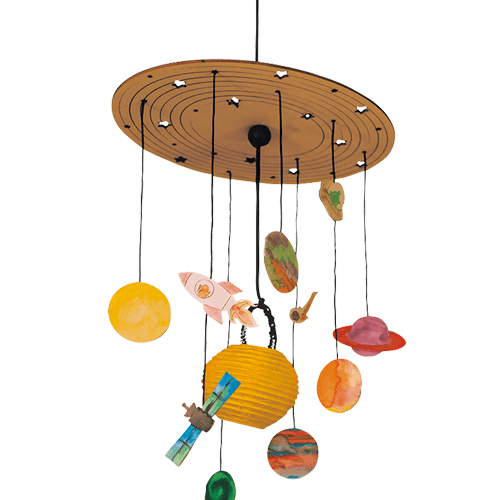
NGSS
1-ESS1-1 Use observations of the sun, moon, and stars to describe patterns that can be predicted.
Activity Applications
Common Core
RI.1.3 Describe the connection between two individuals, events, ideas, or pieces of information in a text.
RI.2.3 Describe the connection between a series of historical events, scientific ideas or concepts, or steps in technical procedures in a text.
RI.3.3 Describe the relationship between a series of historical events, scientific ideas or concepts, or steps in technical procedures in a text, using language that pertains to time, sequence, and cause/effect.
Activity Applications
Make connections between push and pull forces and gameplay on the pinball machine.
RI.1.4 Ask and answer questions to help determine or clarify the meaning of words and phrases in a text.
RI.2.4 Determine the meaning of words and phrases in a text relevant to a grade 2 topic or subject area.
RI.3.4 Determine the meaning of general academic and domain-specific words and phrases in a text relevant to a grade 3 topic or subject area.
Activity Applications
Ask questions and use context clues to learn new vocabulary related to motion and engineering design.
RI.1.5 Know and use various text features (e.g., headings, tables of contents, glossaries, electronic menus, icons) to locate key facts or information in a text.
RI.2.5 Know and use various text features (e.g., captions, bold print, subheadings, glossaries, indexes, electronic menus, icons) to locate key facts or information in a text efficiently.
RI.3.5 Use text features and search tools (e.g., key words, sidebars, hyperlinks) to locate information relevant to a given topic efficiently.
Activity Applications
Use bold print, tip text, headings, and icons to locate key information in the explore! Magazine and Inspiration Sheet.
RI.1.6 Distinguish between information provided by pictures or other illustrations and information provided by the words in a text.
Activity Applications
Examine information given in both illustrations and text and identify how they support each other.
RI.1.7 Use the illustrations and details in a text to describe its key ideas.
RI.2.7 Explain how specific images (e.g., a diagram showing how a machine works) contribute to and clarify a text.
RI.3.7 Use information gained from illustrations (e.g., maps, photographs) and the words in a text to demonstrate understanding of the text (e.g., where, when, why, and how key events occur).
Activity Applications
Refer to illustrations and diagrams to describe scientific concepts.
Kaleidoscope Play
Learn More ➜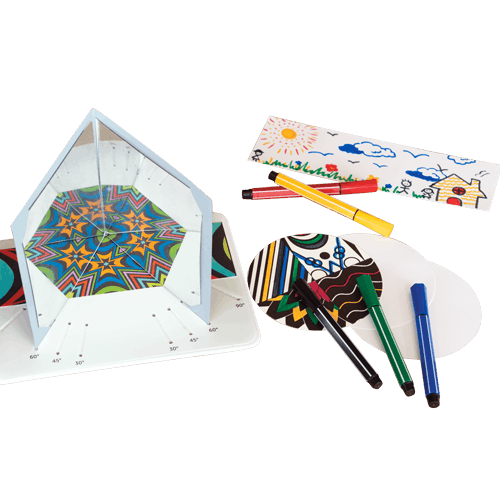
NGSS
1-PS4-2 Make observations to construct an evidence-based account that objects in darkness can be seen only when illuminated.
Activity Applications
Common Core
RI.1.3 Describe the connection between two individuals, events, ideas, or pieces of information in a text.
RI.2.3 Describe the connection between a series of historical events, scientific ideas or concepts, or steps in technical procedures in a text.
RI.3.3 Describe the relationship between a series of historical events, scientific ideas or concepts, or steps in technical procedures in a text, using language that pertains to time, sequence, and cause/effect.
Activity Applications
Identify symmetry and patterns in different objects, as well as describe connections between the steps in technical instructions.
RI.1.4 Ask and answer questions to help determine or clarify the meaning of words and phrases in a text.
RI.2.4 Determine the meaning of words and phrases in a text relevant to a grade 2 topic or subject area.
RI.3.4 Determine the meaning of general academic and domain-specific words and phrases in a text relevant to a grade 3 topic or subject area.
Activity Applications
Ask questions and use context clues to learn new vocabulary related to motion and engineering design.
RI.1.5 Know and use various text features (e.g., headings, tables of contents, glossaries, electronic menus, icons) to locate key facts or information in a text.
RI.2.5 Know and use various text features (e.g., captions, bold print, subheadings, glossaries, indexes, electronic menus, icons) to locate key facts or information in a text efficiently.
RI.3.5 Use text features and search tools (e.g., key words, sidebars, hyperlinks) to locate information relevant to a given topic efficiently.
Activity Applications
Use bold print, tip text, headings, and icons to locate key information in the explore! Magazine and Inspiration Sheet.
RI.1.6 Distinguish between information provided by pictures or other illustrations and information provided by the words in a text.
Activity Applications
Examine information given in both illustrations and text and identify how they support each other.
RI.1.7 Use the illustrations and details in a text to describe its key ideas.
RI.2.7 Explain how specific images (e.g., a diagram showing how a machine works) contribute to and clarify a text.
RI.3.7 Use information gained from illustrations (e.g., maps, photographs) and the words in a text to demonstrate understanding of the text (e.g., where, when, why, and how key events occur).
Activity Applications
Refer to illustrations and diagrams to describe scientific concepts.
Basketball Catapult
Learn More ➜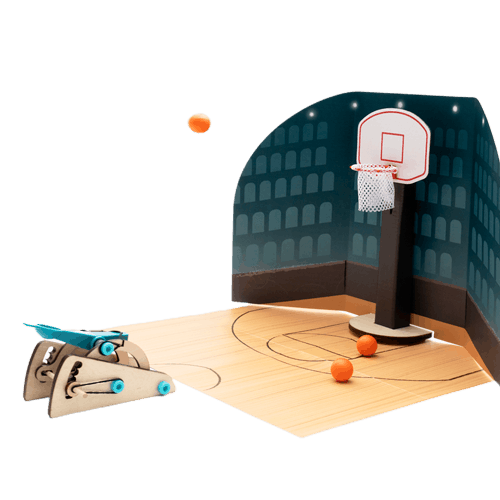
NGSS
5-PS2-1 Support an argument that the gravitational force exerted by Earth on objects is directed down.
Activity Applications
Push down on the catapult’s lever to apply an equal force to the ball and launch it.
Adjust the catapult’s angle and compare how different angles change the ball’s motion.
Common Core
RI.1.3 Describe the connection between two individuals, events, ideas, or pieces of information in a text.
RI.2.3 Describe the connection between a series of historical events, scientific ideas or concepts, or steps in technical procedures in a text.
RI.3.3 Describe the relationship between a series of historical events, scientific ideas or concepts, or steps in technical procedures in a text, using language that pertains to time, sequence, and cause/effect.
Activity Applications
Describe how the catapult’s launch angle affects the arc of the ball, as well as identify connections between steps in the technical instructions.
RI.K.4 With prompting and support, ask and answer questions about unknown words in a text.
RI.1.4 Ask and answer questions to help determine or clarify the meaning of words and phrases in a text.
RI.2.4 Determine the meaning of words and phrases in a text relevant to a grade 2 topic or subject area.
Activity Applications
Ask questions and use context clues to learn new vocabulary related to physics and motion.
RI.1.5 Know and use various text features (e.g., headings, tables of contents, glossaries, electronic menus, icons) to locate key facts or information in a text.
RI.2.5 Know and use various text features (e.g., captions, bold print, subheadings, glossaries, indexes, electronic menus, icons) to locate key facts or information in a text efficiently.
Activity Applications
Use bold print, tip text, headings, and icons to locate key information in the Inspiration Sheet.
RI.1.6 Distinguish between information provided by pictures or other illustrations and information provided by the words in a text.
Activity Applications
Examine information given in both illustrations and text and identify how they support each other.
RI.K.7 With prompting and support, describe the relationship between illustrations and the text in which they appear (e.g., what person, place, thing, or idea in the text an illustration depicts).
RI.1.7 Use the illustrations and details in a text to describe its key ideas.
RI.2.7 Explain how specific images (e.g., a diagram showing how a machine works) contribute to and clarify a text.
Activity Applications
Refer to illustrations and diagrams to describe scientific concepts.
Fun with Flight
Learn More ➜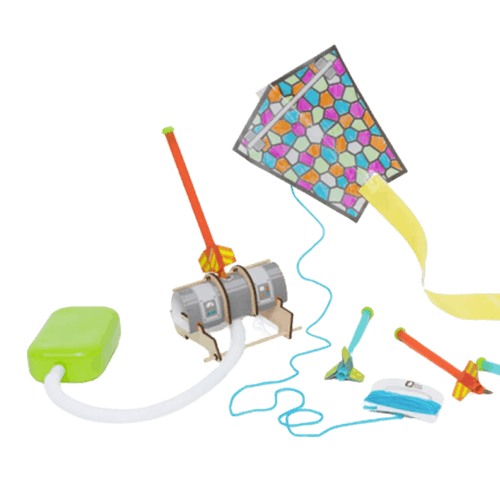
NGSS
K-2-ETS1-1 Ask questions, make observations, and gather information about a situation people want to change to define a simple problem that can be solved through the development of a new or improved object or tool.
Activity Applications
Build a stomp rocket and kite to learn about the science of flight. Adjust the rocket fins and kite tail to test how shape affects the flight path.
Make a helicopter, straw flyer, and airplane out of paper. Explore how their unique shapes cause them to fly differently.
Common Core
RI.K.3 With prompting and support, describe the connection between two individuals, events, ideas, or pieces of information in a text.
RI.1.3 Describe the connection between two individuals, events, ideas, or pieces of information in a text.
RI.2.3 Describe the connection between a series of historical events, scientific ideas or concepts, or steps in technical procedures in a text.
Activity Applications
Compare how rockets, planes, and other aircraft fly.
RI.K.4 With prompting and support, ask and answer questions about unknown words in a text.
RI.1.4 Ask and answer questions to help determine or clarify the meaning of words and phrases in a text.
RI.2.4 Determine the meaning of words and phrases in a text relevant to a grade 2 topic or subject area.
Activity Applications
Ask questions and use context clues to learn domain-specific vocabulary related to flight and aerodynamics.
RI.1.5 Know and use various text features (e.g., headings, tables of contents, glossaries, electronic menus, icons) to locate key facts or information in a text.
RI.2.5 Know and use various text features (e.g., captions, bold print, subheadings, glossaries, indexes, electronic menus, icons) to locate key facts or information in a text efficiently.
Activity Applications
Use bold print, tip text, headings, and icons to locate key information in the Explore! Magazine and Inspiration Sheet.
RI.1.6 Distinguish between information provided by pictures or other illustrations and information provided by the words in a text.
Activity Applications
Examine information given in both illustrations and text and identify how they support each other.
RI.K.7 With prompting and support, describe the relationship between illustrations and the text in which they appear (e.g., what person, place, thing, or idea in the text an illustration depicts).
RI.1.7 Use the illustrations and details in a text to describe its key ideas.
RI.2.7 Explain how specific images (e.g., a diagram showing how a machine works) contribute to and clarify a text.
Activity Applications
Refer to illustrations and diagrams to describe scientific concepts.
Mechanical Sweeper
Learn More ➜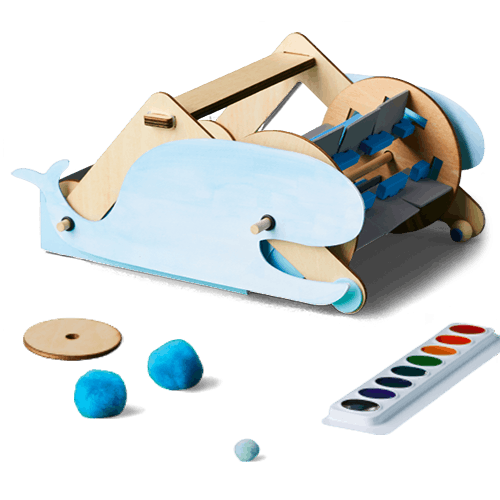
NGSS
K-PS2-1 Plan and conduct an investigation to compare the effects of different strengths or different directions of pushes and pulls on the motion of an object.
Activity Applications
Common Core
RI.K.3 With prompting and support, describe the connection between two individuals, events, ideas, or pieces of information in a text.
RI.1.3 Describe the connection between two individuals, events, ideas, or pieces of information in a text.
RI.2.3 Describe the connection between a series of historical events, scientific ideas or concepts, or steps in technical procedures in a text.
Activity Applications
Compare different types of whales and describe how baleen helps some of them survive.
RI.K.4 With prompting and support, ask and answer questions about unknown words in a text.
RI.1.4 Ask and answer questions to help determine or clarify the meaning of words and phrases in a text.
RI.2.4 Determine the meaning of words and phrases in a text relevant to a grade 2 topic or subject area.
Activity Applications
Ask questions and use context clues to learn domain-specific vocabulary related to whales and marine biology.
RI.1.5 Know and use various text features (e.g., headings, tables of contents, glossaries, electronic menus, icons) to locate key facts or information in a text.
RI.2.5 Know and use various text features (e.g., captions, bold print, subheadings, glossaries, indexes, electronic menus, icons) to locate key facts or information in a text efficiently.
Activity Applications
Use bold print, tip text, headings, and icons to locate key information in the Explore! Magazine and Inspiration Sheet.
RI.1.6 Distinguish between information provided by pictures or other illustrations and information provided by the words in a text.
Activity Applications
Examine information given in both illustrations and text and identify how they support each other.
RI.K.7 With prompting and support, describe the relationship between illustrations and the text in which they appear (e.g., what person, place, thing, or idea in the text an illustration depicts).
RI.1.7 Use the illustrations and details in a text to describe its key ideas.
RI.2.7 Explain how specific images (e.g., a diagram showing how a machine works) contribute to and clarify a text.
Activity Applications
Refer to illustrations and diagrams to describe scientific concepts.
Capillary Action
Learn More ➜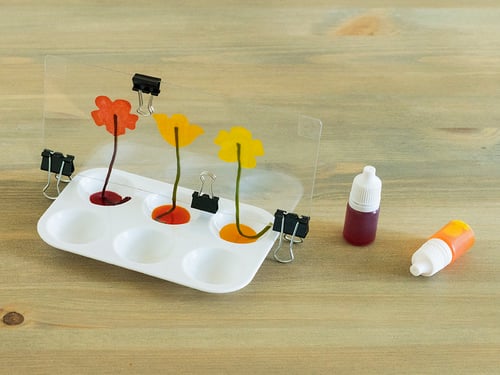
NGSS
MS-LS1-7 Develop a model to describe how food is rearranged through chemical reactions forming new molecules that support growth and/or release energy as this matter moves through an organism.
K-LS1-1 Use observations to describe patterns of what plants and animals (including humans) need to survive.
1-LS1-1 Use materials to design a solution to a human problem by mimicking how plants and/or animals use their external parts to help them survive, grow, and meet their needs.
Activity Applications
2-LS2-1 Plan and conduct an investigation to determine if plants need sunlight and water to grow.
Activity Applications
Common Core
RI.K.3 With prompting and support, describe the connection between two individuals, events, ideas, or pieces of information in a text.
RI.1.3 Describe the connection between two individuals, events, ideas, or pieces of information in a text.
RI.2.3 Describe the connection between a series of historical events, scientific ideas or concepts, or steps in technical procedures in a text.
Activity Applications
Make connections between capillary-action experiments (like using food coloring to dye flowers) and how trees rely on capillary action to survive.
RI.K.4 With prompting and support, ask and answer questions about unknown words in a text.
RI.1.4 Ask and answer questions to help determine or clarify the meaning of words and phrases in a text.
RI.2.4 Determine the meaning of words and phrases in a text relevant to a grade 2 topic or subject area.
Activity Applications
Ask questions and use context clues to learn domain-specific vocabulary related to capillary action and plant life.
RI.1.5 Know and use various text features (e.g., headings, tables of contents, glossaries, electronic menus, icons) to locate key facts or information in a text.
RI.2.5 Know and use various text features (e.g., captions, bold print, subheadings, glossaries, indexes, electronic menus, icons) to locate key facts or information in a text efficiently.
Activity Applications
Use bold print, tip text, headings, and icons to locate key information in the Explore! Magazine and Inspiration Sheet.
RI.1.6 Distinguish between information provided by pictures or other illustrations and information provided by the words in a text.
Activity Applications
Examine information given in both illustrations and text and identify how they support each other.
RI.K.7 With prompting and support, describe the relationship between illustrations and the text in which they appear (e.g., what person, place, thing, or idea in the text an illustration depicts).
RI.1.7 Use the illustrations and details in a text to describe its key ideas.
RI.2.7 Explain how specific images (e.g., a diagram showing how a machine works) contribute to and clarify a text.
Activity Applications
Refer to illustrations and diagrams to describe scientific concepts.
Astronaut Starter Kit
Learn More ➜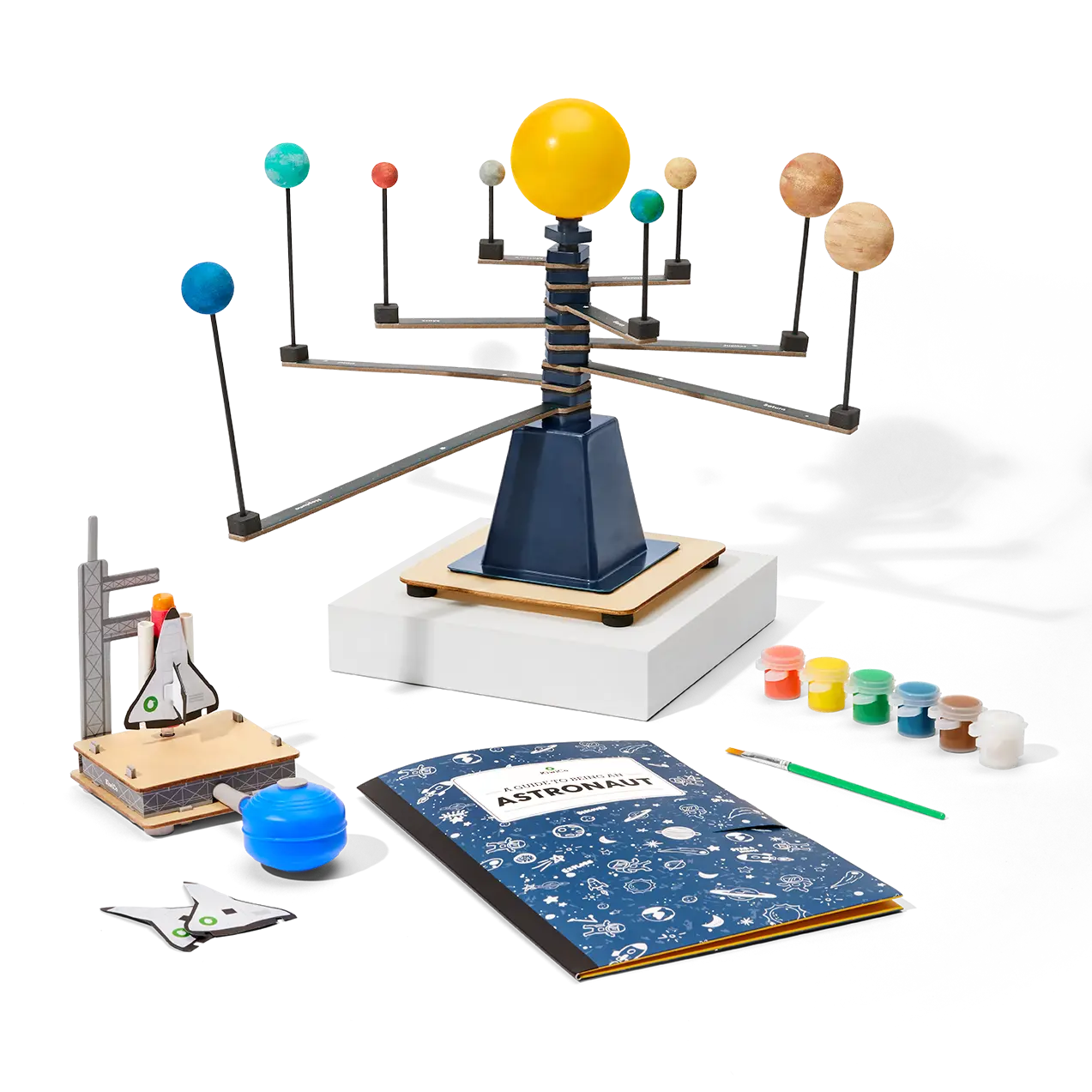
NGSS
1-ESS1-1 Use observations of the sun, moon, and stars to describe patterns that can be predicted.
1-ESS1-2 Make observations at different times of year to relate the amount of daylight to the time of year.
Activity Applications
Build a solar system mobile to explore how planets orbit the Sun in a predictable pattern.
Common Core
RI.K.3 With prompting and support, describe the connection between two individuals, events, ideas, or pieces of information in a text.
RI.1.3 Describe the connection between two individuals, events, ideas, or pieces of information in a text.
RI.2.3 Describe the connection between a series of historical events, scientific ideas or concepts, or steps in technical procedures in a text.
Activity Applications
Identify relationships between planets in the solar system, including how big they are and what they look like.
Describe milestones in space travel and what it’s like being an astronaut.
RI.K.4 With prompting and support, ask and answer questions about unknown words in a text.
RI.1.4 Ask and answer questions to help determine or clarify the meaning of words and phrases in a text.
RI.2.4 Determine the meaning of words and phrases in a text relevant to a grade 2 topic or subject area.
Activity Applications
Ask questions and use context clues to learn domain-specific vocabulary related to space travel, solar system, and scientific exploration.
RI.1.5 Know and use various text features (e.g., headings, tables of contents, glossaries, electronic menus, icons) to locate key facts or information in a text.
RI.2.5 Know and use various text features (e.g., captions, bold print, subheadings, glossaries, indexes, electronic menus, icons) to locate key facts or information in a text efficiently.
Activity Applications
Use bold print, tip text, headings, and icons to locate key information in the Astronaut’s Guide, poster, and instructions.
RI.1.6 Distinguish between information provided by pictures or other illustrations and information provided by the words in a text.
Activity Applications
Examine information given in both illustrations and text and identify how they support each other.
RI.K.7 With prompting and support, describe the relationship between illustrations and the text in which they appear (e.g., what person, place, thing, or idea in the text an illustration depicts).
RI.1.7 Use the illustrations and details in a text to describe its key ideas.
RI.2.7 Explain how specific images (e.g., a diagram showing how a machine works) contribute to and clarify a text.
Activity Applications
Refer to illustrations and diagrams to describe scientific concepts.
Veterinarian Starter Kit
Learn More ➜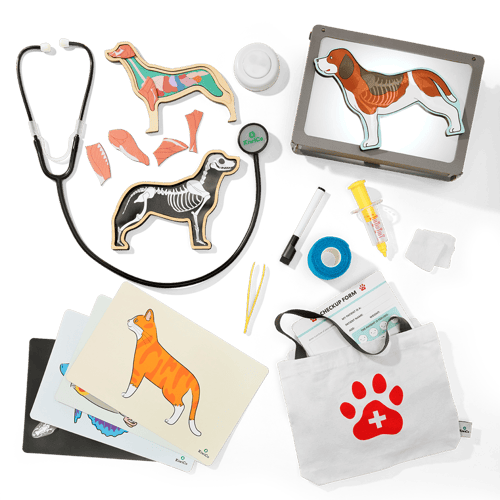
NGSS
K-LS1-1 Use observations to describe patterns of what plants and animals (including humans) need to survive.
Activity Applications
Common Core
RI.K.3 With prompting and support, describe the connection between two individuals, events, ideas, or pieces of information in a text.
RI.1.3 Describe the connection between two individuals, events, ideas, or pieces of information in a text.
RI.2.3 Describe the connection between a series of historical events, scientific ideas or concepts, or steps in technical procedures in a text.
Activity Applications
Draw connections between animal body language, behaviors, and symptoms.
RI.K.4 With prompting and support, ask and answer questions about unknown words in a text.
RI.1.4 Ask and answer questions to help determine or clarify the meaning of words and phrases in a text.
RI.2.4 Determine the meaning of words and phrases in a text relevant to a grade 2 topic or subject area.
Activity Applications
Ask questions and use context clues to learn domain-specific vocabulary related to veterinarians, animal anatomy, and biology.
RI.1.5 Know and use various text features (e.g., headings, tables of contents, glossaries, electronic menus, icons) to locate key facts or information in a text.
RI.2.5 Know and use various text features (e.g., captions, bold print, subheadings, glossaries, indexes, electronic menus, icons) to locate key facts or information in a text efficiently.
Activity Applications
Use bold print, tip text, headings, and icons to locate key information in the Veterinarian’s Guide, poster, and instructions.
RI.1.6 Distinguish between information provided by pictures or other illustrations and information provided by the words in a text.
Activity Applications
Examine information given in both illustrations and text and identify how they support each other.
RI.K.7 With prompting and support, describe the relationship between illustrations and the text in which they appear (e.g., what person, place, thing, or idea in the text an illustration depicts).
RI.1.7 Use the illustrations and details in a text to describe its key ideas.
RI.2.7 Explain how specific images (e.g., a diagram showing how a machine works) contribute to and clarify a text.
Activity Applications
Refer to illustrations and diagrams to describe scientific concepts.
Environmental Science: Oil Cleanup
Learn More ➜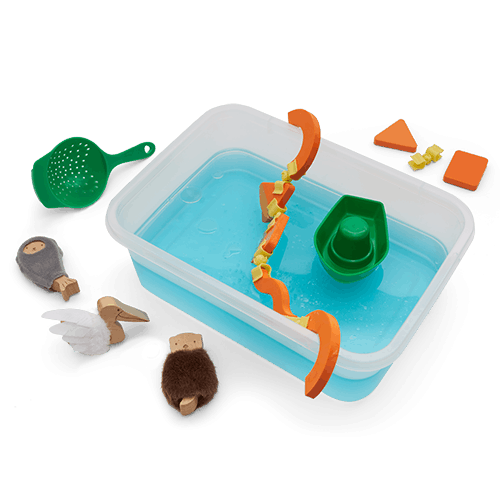
NGSS
2-PS1-1 Plan and conduct an investigation to describe and classify different kinds of materials by their observable properties.
Activity Applications
Common Core
Environmental Science: Oil Cleanup
Learn More ➜
NGSS
Common Core
Air Hockey
Learn More ➜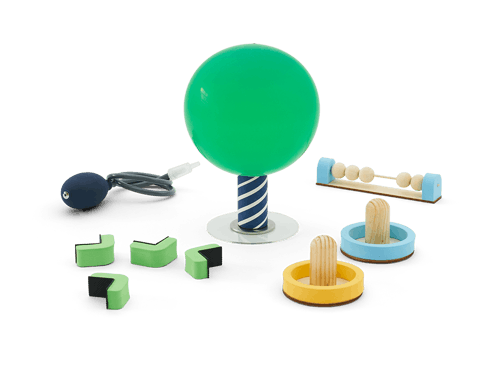
NGSS
3-PS2-1 Plan and conduct an investigation to provide evidence of the effects of balanced and unbalanced forces on the motion of an object.
Activity Applications
Common Core
Air Hockey
Learn More ➜
NGSS
3-PS2-2 Make observations and/or measurements of an object’s motion to provide evidence that a pattern can be used to predict future motion.
Activity Applications


